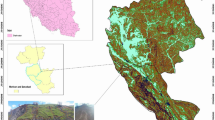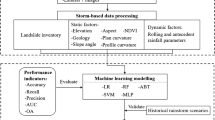Abstract
Landslide prediction is complex and involves many factors, such as geotechnical, geological, topographical, and even meteorological. This work presents a methodology by using a Data Mining approach in order to predict landslide occurrences induced by rainfall in Rio de Janeiro city. Landslide and rain data records from 1998 to 2001 were obtained from field technical reports and 30 automatic rain gauges, respectively. It was also collected data regarding soil parameters, including urban areas, forest, vulnerability, among others, and totalizing 46 soil variables. All the information was inserted into a Geographic Information Systems. Clustering (Dendrogram and k-means) and Statistical (Principal Component Analysis and Correlation) techniques were used to regionalize the rain data and select the rain gauges to be input on Artificial Neural Networks , which were used to replace the missing rain values. The landslide volume variable also presented missing values and it was completed by the k-Nearest Neighbor method. After data preparation, some models were built to predict landslide and rainfall using Data Mining techniques. The obtained model’s performance is also analyzed.









Similar content being viewed by others
References
Agrawal R, Srikant R (1994) Fast algorithms for mining association rules. VLDB-94, 1994
Babu GLS, Mukesh MD (2001) Landslide analysis in geographic information systems. Department of Civil Engineering, Indiana Institute of Science, Bangalore
Bishop C (1995) Neural networks for pattern recognition. University Press, Oxford
Chawla N, Japkowicz N, Kolcz A (2004) Special issue on learning from imbalanced datasets (Editorial). In: SIGKDD Explorations, vol 6, pp 1–6
Duda RO, Hart PE, Stork DG (2001) Pattern classification, 2nd edn. Wiley Interscience, New York
Gorsevski PV, Gessler PE, Jankowski P (2003) Integrating a fuzzy k-means classification and a Bayesian approach for spatial prediction of landslide hazard. J Geogr Syst 5(3):223–251
Haikin S (2001) Redes Neurais—Princípios e Prática, 2nd edn. Bookman, Porto Alegre
Han J, Kamber H (2001) Data mining—concepts and techniques, Chapters 7 and 8. Morgan Kaufmann, San Francisco
Hruschka ER, Hruschka Jr ER, Ebecken NFF (2003) Evaluating a nearest-neighbor method to substitute continuous missing values. In: Australian conference on artificial intelligence, pp 723–734
Kaufman L, Rousseeuw PJ (1990) Findings groups in data: an introduction to cluster analysis. In: Wiley series in probability and mathematical statistics, Wiley, New York
Kennedy R, Lee Y, Reed C, Roy BV (1997) Solving pattern recognition problems. Unica Technologies, Lincoln
Lin CY, Chuang CW, Lin WT, Chou WC (2009) Vegetation recovery and landscape change assessment at Chiufenershan landslide area caused by Chichi earthquake in central Taiwan. J Nat Hazards 53(1)
Liu B, Hsu W, Chen S, Ma Y (1998) Integrating classification and association rule mining. In: KDD-98, New York
Liu B, Hsu W, Chen S, Ma Y (2000) Analyzing the subjective interestingness of association rules. In: IEEE Intelligent Systems, National University of Singapore, Singapore
Melchiorrea C, Matteuccib M, Azzonic A, Zanch A (2008) Artificial neural networks and cluster analysis in landslide susceptibility zonation. Geomorphology 94(3–4):379–400
Menezes WF, Paiva LMS, Silva MGAJ, Belassiano M (2000) Estudo do Ambiente Favorável à Propagação de Sistemas Convectivos de Mesoescala sobre o Município do Rio de Janeiro. In: XI Congresso Brasileiro de Meteorologia, Rio de Janeiro
Mitchell TM (1997) Machine learning. McGraw Hill, New York
Pearson K (1896) Regression, heredity, and panmixia. In: Philosophical transactions of the royal society of London, Ser. A, vol 187, pp 253–318
Pyle D (1999) Data preparation for data mining. Morgan Kaufmann Publishers, San Francisco
Rumelhart DE, McClelland J (1986) Parallel distributed processing, vol 1. MIT Press, Cambridge, MA
Souza FT (2004) Predição de Escorregamentos das Encostas do Município do Rio de Janeiro através de Técnicas de Mineração de Dados (in Portuguese). Doctoral thesis, COPPE/UFRJ–Federal University of Rio de Janeiro, Rio de Janeiro
Souza FT, Ebecken NFF (2003) A data mining approach for landslide analysis caused by rainfall in Rio de Janeiro. In: Proceedings of the international conference on slope engineering, Hong Kong, 8–10 December, pp 611–616
Souza FT, Ebecken NFF (2004) Preparação de Dados de Chuvas Intensas utilizando Técnicas de Mineração de Dados (in Portuguese), vol 9, 1st edn. Revista Brasileira de Recursos Hídricos, ABRH, RS, pp 181–187
Souza FT, Ebecken NFF (2004) Landslides data preparation for data mining. In: Proceedings of the IX international symposium on landslides, vol 1, Rio de Janeiro, June and July, Balkema, pp 429–434
Souza FT, Ebecken NFF (2004) A data mining approach to landslides prediction. In: Proceedings of the data mining V—data mining, text mining and their business applications, Malaga, 15–17 September, WITPress, pp 423–432
Ting KM, Zheng Z (1998) Boosting trees for cost-sensitive classifications. In: Proceedings of the tenth European conference on machine learning, LNAI-1398. Springer, Berlin, pp 190–195
Weiss GM (2004) Mining with rarity: a unifying framework. In: SIGKDD Explorations, vol 6, pp 7–19
Wherry RJ (1984) Contributions to correlational analysis. Academic Press, New York
Acknowledgments
We are deeply grateful to FAPERJ, who provided the financing, as well as the following institutes, which have furnished the data to perform this work: GEORIO; SMAC; SERLA; INMET; UERJ; UFRJ; Wyoming Univ.; DHN; DECEA and CPRM.
Author information
Authors and Affiliations
Corresponding author
Rights and permissions
About this article
Cite this article
de Souza, F.T., Ebecken, N.F.F. A Data Based Model to Predict Landslide Induced by Rainfall in Rio de Janeiro City. Geotech Geol Eng 30, 85–94 (2012). https://doi.org/10.1007/s10706-011-9451-8
Received:
Accepted:
Published:
Issue Date:
DOI: https://doi.org/10.1007/s10706-011-9451-8




